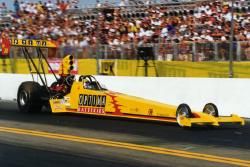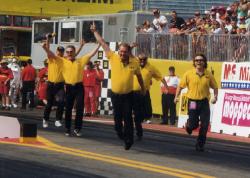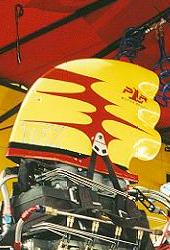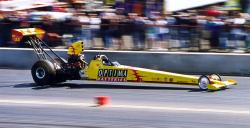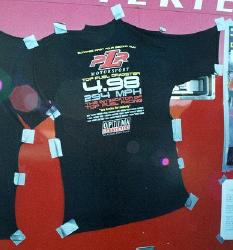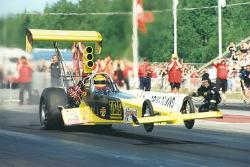 |
||||||||||||
|
Remembering the first Four 
Europe's first four-second Top Fuel Dragster pass took place at the NitrolympX at Hockenheim in Germany on 16th August 1997. Kent Persson clocked 4.987 seconds in Peter Lantz's Top Fueller which was tuned by Peter and Morgan Svensson and which was equipped with the revolutionary Sharkfin injector. We spoke to Peter Lantz, Kent Persson and Eddie Corr in August 2007, the tenth anniversary of the historic run, about their memories of the Four as well as Peter's thoughts about Top Fuel Dragster then and now. Morgan Svensson also contributed to the interview. The above picture and the first two pictures below are ©Remco Scheelings and are used with his kind permission. Click on any picture below for large version. Eurodragster.com: Set the scene for the four-second run. How had your season gone up to that point? Peter Lantz: The game plan for the 1997 season was to have a low profile. I almost went bankrupt
the year before so I had a big weight on my shoulders. Therefore I felt that I would like to help Kent Persson with his "illness" of not driving a car!
It would give me a more relaxed time outside of the car tuning it with Morgan. Our plan was to run at Pite Dragway and Mantorp Park and perhaps at
Santa Pod Raceway.
Eddie Corr: I was there training I guess. I had become Crew Chief for Andy Carter and because we ran a Lantz injector on our car Peter kindly offered to try and bring me on in the tuning department by exposing me to how his team worked. So in exchange for some "Tuning for Dummies" classes, for three races that season I did one of the heads and tried to keep up with the Swedish drinking and hospitality! Peter Lantz: We won the Piteå event, and we made the finals at Mantorp Park but a ring gear stopped us winning the final when we had more than a
car length over Rico Anthes. As usual we ran in all the qualifying sessions regardless of how well we had done, and we put on a great show.
Eddie Corr: An early indication to me that this team, more
than any other, would run the first four was Peter and Morgan's use of the Pi System 5 logger.
At the time Viveca and Rico, among others, were running US tune-ups
in pursuit of the four, and had come very close with Viveca running 5.0s
off the throttle etc. Peter's car was famed for running bracket
5.20s; that was still two tenths away from the four, but the team's
knowledge of what the car was doing and their understanding of it
impressed me. After my first visit to Sweden that year I told Andy Carter
"Forget the 5.0 cars, Peter's car will run the first four".
Eurodragster.com: Did you go to Hockenheim expecting to run a four? Peter Lantz: No question, that was our main goal. But many teams had been trying to do it for a long time, with all kind of different resources. But in my heart I knew that our knowledge gave us an edge over the others. Eddie Corr: Morgan seemed confident that this would be the weekend to "try something". He had identified a new more aggressive target for the clutch gradient, and in combination with our second eighth ideas we thought that if it all worked then Kent would be in for the ride of his life, knocking on the door of the four-second barrier! Eurodragster.com: What runs did you make at Hockenheim before the four? Peter Lantz: The plan was to run a half pass to see if we got the answers we wanted, and we got those answers. For us the conditions were right, we knew we could make it on the next run. Eddie Corr: It was very fortunate that the first pass was only to half-track. Peter
had made some nice new headers for the car, real works of art, nicer
than any Dynomax pieces. Well we obliterated them on that half pass!
They were hanging off the car like bits of tin foil. The tie bars had
been made solid, and so the exhaust gas pressure gave us a demonstration
of tube bending on that run, followed by a demonstration in tube
bursting! We were very lucky to get away with that! So we fitted some headers
with sliding joints on the stay bars! Most of the nice new thermocouples
I had supplied had been destroyed too, so no more exhaust temperature data, but
we did have the clutch and fuel data.
Peter Lantz: I showed Kent four fingers before he staged, and it was all in place. Eurodragster.com: And then 4.98 seconds later...
Eddie Corr: All runs with a Top Fuel car are hard, you're always at the start line
basically exhausted from all the effort to service the thing and whatever number comes up on the board, as long as it's a
clean full pass, you take some positives from it. In the second qualifying session, we were in the left lane and Kent made
a nice smooth full pass. It was a real cartoon double-take when we saw those scoreboards. With the speed in kilometres per
hour it looked even better!
Peter Lantz: I know that Kent knew the run was good, but not that it was a four. He was off the throttle slowly after 4.5 seconds because the finish line was hard to see. But he soon realised when he saw our faces. Even my heavy body left the ground for a moment! Kent Persson: As I crossed the finish line I knew we had run fast. The top end acceleration was crazy - although I loved it! - and it was a big difference to previous runs so I thought it was a good speed. No-one had talked about a four, it surprised everyone. When the crew came to pick me up they were screaming and shouting! Eurodragster.com: What were the incrementals on the timing slip? Peter Lantz: The full numbers were:
Eddie Corr: Kent said that the headrest in the car
needed to be padded further forwards again because the pull from the car
in the second eighth was so strong that his head was still going backwards
and affecting his vision. His foot was actually lifting from one hundred per
cent throttle back to ninety three per cent after 3.5 seconds too!
Kent Persson: It was a terrific weekend. I didn't realise that it was such a big thing until I started to hear from people all over the world - America, Australia, Japan. It was a good feeling. Eurodragster.com: What did you change on the car to make a low-five car a 4.9 car? Peter Lantz: After Mantorp we had updated the mags, to 7.2 amps if I remember rightly,
I know that each mag cost me $1500. Compare 7.2 to the 44 amp mags today! Then we made changes to the set-up, in this case timing on
the clutch and fuel. We also had a different blower and a repaired fuel pump.
Eddie Corr: Technically, the car was running that well that the plugs looked like they could have made another run! The Lantz way of tuning a Top Fuel car differs slightly from the classic NHRA/big-hitting type of tuning. It is very easy on the motor, and it's a method which has influenced more than one of the tuners in the pits today. Eurodragster.com: There was a huge pick-up in speed between the eighth mile and the finish line. Was that the effect of the Sharkfin injector? Peter Lantz: That injector had the advantage over the old style that it added lots of PSI at the top end, so of course that was a part of it. But it was in combination with other changes we made on the car as well.
Peter Lantz: There were a lot of reasons it was more efficient than a "birdcatcher", which was the only injector available at the time. And as Morgan works with airflow as his profession, he made some drawings and explained to me how he believed it should look. There were four major reasons it looked like it did:
I think the four came partly out of the performance of the injector, and partly out of a lot of anger as explained above. Eurodragster.com: Looking at the injectors used by some US teams it is plain to see the ancestry of the Sharkfin. Did you work with anyone in the USA or did they just take your ideas and build upon them? Peter Lantz: No, we did not work with any US racer or manufacturer. They are very suspicious of anything which isn't made in the USA. But as I mentioned earlier the birdcatcher was the only thing available to put on top of a blower at the time. So I guess the Sharkfin opened up some eyes over there, because now there is a whole bunch of different injectors to choose from. And some of them are pretty much Sharkfin lookalikes.
Peter Lantz: Yes, it was surprising. We were hoping to repeat soon after we ran the first four, and also to be first over 300 mph. But it was hard to do. The tracks were really tricky to tune for at that time. But if I remember rightly Rico was really close to breaking into the fours with a 5.01 one or two years before us. And no one can accuse Rico of not trying hard enough. Eddie Corr: It took another five years of competition
to go the next six miles per hour and break 300 mph! Even now not every run is a four:
we turn up and qualify with a five first, and then pull out the four-second tune-up
for the second qualifier onwards. You could count on the fingers of one hand the number
of European teams who have run all fours in a race weekend.
Eurodragster.com: A Fuel tuner once told me that there was a big difference between tuning a 5.0 and a 4.9, and also that there was a huge difference between making a car go 299 mph and making it go 300 mph. Would you agree? Peter Lantz: No, I would not say that. The problem for European racers is more difference
between track conditions and a lack of testing opportunities. So a different track could mean a completely different tune-up.
Eurodragster.com: You're now working with Jöran Persåker. Has the tune-up changed drastically since you tuned the four, or are Morgan and yourself still using the same basic set-up?
Eurodragster.com: What do you think of Top Fuel as it is in Europe right now? Peter Lantz: Last year and this year there has been a big improvement. Lex, Urs, and
Karsten and Per and others have brought it to another level. It's nice to see there is teams owning their own cars joining Top Fuel because that is
very important. Rent-a-cars need to be there but there cannot be too many if they don't perform, and we have seen enough of that.
I was in the grandstand at last year's European Finals at the Pod, and Top Fuel was not popular on Friday and Saturday. The
oildowns were too much and the fans went crazy. But when Pro Mod entered the bleach box they where screaming.
I think it has improved a lot this year and still needs to do so.
Eurodragster.com: Would you get back in a Top Fuel Dragster yourself?
Kent Persson: When Peter spoke to me the other day and said it was ten years ago I didn't believe him! I am really missing it today. I was never very good at promoting myself to sponsors so in the end I didn't have the money to race. When you have been involved for thirty years it's a serious change to stop, you really have to change your lifestyle. I talk to people about this feeling and they don't believe me, but when they quit they will understand. Eddie Corr: The four-second run was one of many experiences with the PLR team which got me into the game of running Fuel cars. Peter and Morgan are still at the track and two nicer guys you will not meet. Christian works on Charley Karling's Supertwin; I never see Manne or Vidar now, although I have bumped into Kent once or twice. I'm glad I got the chance to be a part of it all, and what a weekend it was! And thanks once again to Christian, Kent, Manne, Magnus, Morgan, Peter, Stefan and Vidar for making it all happen. Eurodragster.com: Thank you very much for your time, guys, and
good luck to Peter, Morgan and Eddie tuning your respective cars at the European Finals.
Features and Interviews index Back to News page |
